
![]()
![]()
| NSF Project Report
DEB-0071655, $391,128, 1 September 200028 February 2002 BIODIVERSITY OF SAKHALIN ISLAND INTERNATIONAL SAKHALIN ISLAND PROJECT (ISIP)
|
| GOALS.Following the success of our seven consecutive field-seasons of survey and inventory on the islands of the Kuril Archipelago (see 1994, 1995, 1996, 1997, 1998, 1999, and 2000), the primary goal of this one-year grant was to extend our efforts to the island of Sakhalin: to survey as much of the island as possible in an eight-week expedition, focusing on lichens, mosses, liverworts, fungi, vascular plants, insects, spiders, freshwater and terrestrial mollusks, freshwater fishes, amphibians, and reptiles. Additional tasks included the following: (1) sort, identify, and curate whole specimens and ethanol-fixed tissues for future study; (2) develop a database of collection localities, specimens, and taxa for use in later studies; (3) make the immediate results of the surveydatabases, written information, and preserved collectionswidely available as quickly as possible to researchers around the world; (4) provide training, field experience, and research opportunities for students and professional biologists of all three participating nations; and (5) describe new species, publish various articles in the popular and peer-reviewed literature, and prepare keys, guides, and annotated checklists of the biota of Sakhalin Island. Progress to date toward attaining these project goals has been excellent.
|
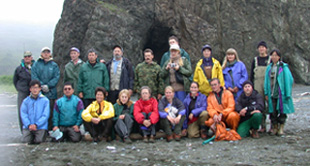 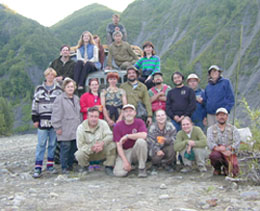 2001 ISIP ship-based participants (left) in northern Sakhalin and land-based participants in central Sakhalin (right). Photo by Wataru Abe (left) and Dan Bennett (right).
|
|
RESULTS TO DATE.The expeditionary phase of the work, which took place from 12 July through 4 September, was completely successful. Instead of relying totally on a research vessel to provide access to habitats (as was required over the last seven years in the much smaller, individually isolated, and remote Kuril Islands), we launched simultaneous land-based and ship-based approaches, allowing for a much wider coverage of territory and habitats, and vastly increasing both the diversity and quantity of material collected. A "terrestrial" team of 23, including seven Americans, eleven Russians, and five Japanese students and professionalsusing a field station of the Institute of Biology and Soil Sciences of the Russian Academy of Sciences located at Sokol, Sakhalin Islandcollected throughout the southern part of the island. At the same time, a ship-based team of 24, including seven Americans, thirteen Russians, and four Japanese students and professionals, sailed up the eastern and northern coasts of Sakhalin aboard the 99-m R/V OKEAN, stopping to collect at some 25 localities along the way. Collections were made at 1,432 sites (see Databases and Map-based locality record browser) in widely varying habitats, similar to those collected in previous years on the Kuril Islands (see Macro- and microhabitats): from sea-level sandy-, rocky-beach, and grassland to high-mountain stream/conifer forest; from deep, slow-moving lowland rivers to fast-flowing gravelly streams; and from sphagnum bogs to high mountain lakes.
|
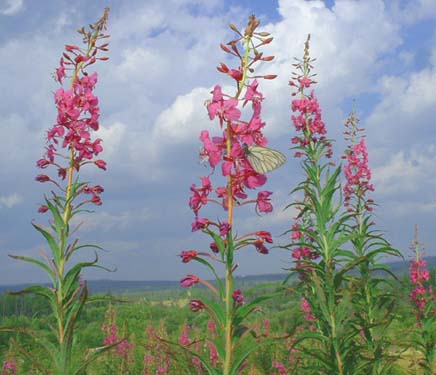 Meadow with a "black-veined white" Aporia crateagiad herbal on the fireweed Epilobium angustifolium in central Sakhalin Island. Photo by Noboru Minakawa.
|
Collecting was confined primarily to lichens, mosses, liverworts, fungi, vascular plants, aquatic and terrestrial insects, spiders and harvesters, freshwater and anadromous fishes, amphibians, and reptiles (but smaller collections of marine algae, pseudoscorpions, decapods, centipedes, millipedes, and marine fishes were also made). For the land-based team, the primary working facility was a biological field station of the Russian Academy of Sciences, maintained by the Institute of Biology and Soil Sciences, located just outside the village of Sokol, about 50 minutes by car from Yuzhno-Sakhalinsk, the capital city of the island. The station provided all the necessary requirements: sleeping quarters for 24 scientists, adequate laboratory space, and a fully equipped kitchen and support staff. Food and other supplies were readily available at Sokol. Cars and local drivers provided transportation around the island; but more importantly, especially for more distant collecting sites, train transportation was usedthe Sakhalin railway network extends the entire length of the island and provides daily access to all the major towns.
|
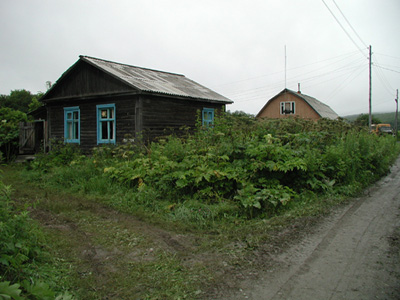 Base camp in Sokol, southern Sakhalin Island.
|
|
The members of the ship-based team made their quarters aboard the 99-m OKEAH, the same research vessel of the Russian Academy of Sciences that we used last year for our final expedition in the Kuril Islands (the 68.8-m PROFESSOR BOGOROV was used in 1994, 1995, and 1997; the 75-m AKADEMIK OPARIN in 1996, 1998, and 1999). Although old and too big for our needs, the ship was comfortable enough and very ably managed by Captain Eugenyi A. Sklizkov and his crew of 42 (see Russian Research Vessels).
|
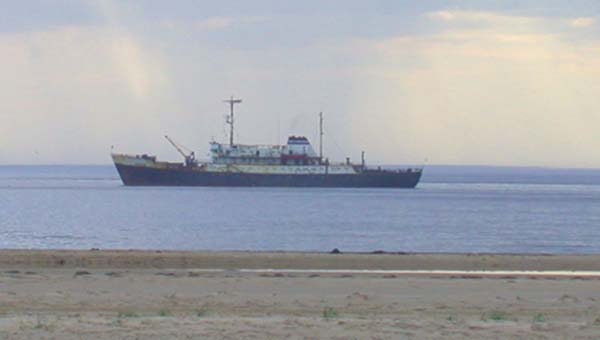 The 99-meter R/V OKEAH commanded by Captain Yevgeniy A. Sklizkov, a vessel of the Russian Academy of Sciences. Photo by Wataru Abe.
|
|
RESEARCH PRODUCTS.The dual approach to collecting, by land and by sea, allowed us to take a significantly greater number of people this year, our coverage was more extensive, and collecting was considerably more efficientthe land-based entomologists, for example, were able to set light-traps repeatedly night after night and have easy access to results each morning.. The overall result was a significant increase in the amount of material collected. Although counts are still preliminary, approximately 67,966 specimens were successfully exported to the U.S. (compared to 41,265 specimens exported in 2000; 54,177 in 1999; 63,235 in 1998; 53,155 in 1997; 63,700 in 1996; 45,080 in 1995; and 29,600 in 1994):
|
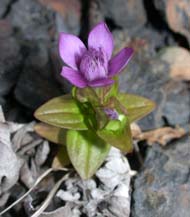 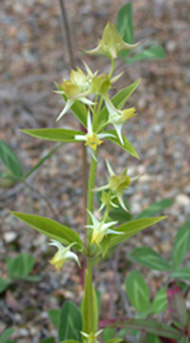 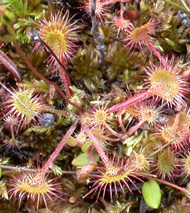 The gentians Gentiana jamesii (left) and Halenia corniculata (center), and the round-leaf sundew Drosera rotundifolia (right). Photos by Wataru Abe.
|
|
Lichens, mosses, liverworts, fungi, and vascular plants (including ferns and their allies): about 3,486 specimens of vascular plants, representing 70 families and at least 200 species (all collected in replicates of three); plus about 1,142 specimens of lichens, 972 bryophytes (mosses and liverworts), and 330 macrofungi, for a grand total of approximately 5,930 specimens; this material includes at least six new records of vascular plants for the island and, among lichens and bryophytes, at least 12 new records. Aquatic insects: 7,517 specimens including 10 orders and 29 families: 804 Coleoptera, 302 Diptera, 466 Ephemeroptera, 220 Hemiptera, 19 Megaloptera, 27 Neuroptera, 320 Odonata, 448 Plecoptera, 4,844 Trichoptera, other 67. The material undoubtedly includes new taxa and many new records. Terrestrial insects: at least 45,000 specimens, representing 12 orders, about 90 families, and well in excess of 750 species; the material undoubtedly includes new taxa and many new records, but much of the collection has not yet been sorted to family. Some groups, however, have already been made available to taxonomists (Odonata, braconid Hymenoptera, and histeridae Coleoptera), and species-level identifications for some groups are expected soon. Insect collecting was largely improved by the use of pitfall traps and malaise traps that operated continuously at many sites during the expedition. |
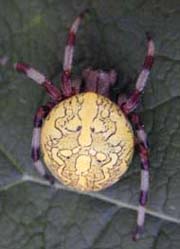 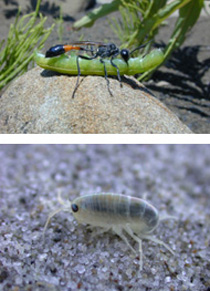 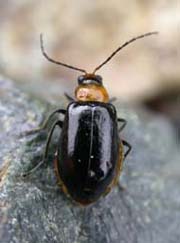 Various specimens: the spider Araneus marmoreus (left), a Sphecid wasp Ammophila sp. carrying a paralyzed Geometrid caterpillar (top center), a Talitrid amphipod (bottom center), the Chrysomelid beetle (right). Photos by Dan Bennett (left), Trevor Anderson (top center, right) and Wataru Abe (bottom center).
|
|
Spiders and harvesters: about 6,180 specimens, representing 13 families and at least 80 species; additional new records and perhaps new species may be expected, but most of the material remains unsorted and identified. Crustaceans: About 1,500 freshwater and marine specimens, including 13 species of Decapoda (4 species of Brachyura, 7 species of Caridea, 1 pagurid and 1 astacid); over 20 species of Amphipoda; 11 species of Isopoda, five species of Mysidacea and one conchostracan, with some probable new records. In addition, there are some large unsorted samples of freshwater microcrustacea including several species of Copepoda and Cladocera. Mollusks: Approximately 130 specimens, primarily of intertidal marine prosobranchs; plus 2 species of freshwater bivalves. New records or species are unlikely. Freshwater and intertidal fishes: 4,138 specimens, seventeen families, and 49 species, including four species not previously recorded from Sakhalin Island (the cyprinids Pseudogobio rivularis and Pseudorasbora parva, the osmerid Hypomesus chishimaensis, and the cottid Cottus poecilopus). Amphibians and reptiles: 15 specimens, three families, and three species.
|
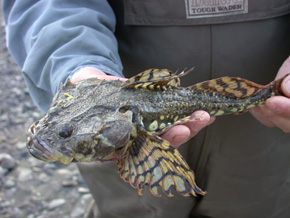 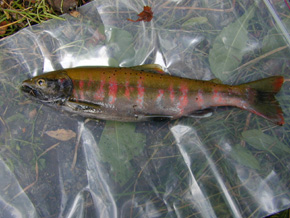 Mamoru Yabe holding the cottid Myoxocephalus sp. (left), and the salmonid Oncorhynchus masou from Sakhalin (right). Photos by Wataru Abe (left)Trevor (right).
|
|
|
 Salamandrella keyserlingii from Sakhalin Island. Photo by Jessica Ward.
|
|
The plants, insects, spiders and harvesters, fishes, amphibians, and reptiles, are presently being processed here at the University of Washington in the Department of Botany, Burke Museum of Natural History and Culture, and School of Aquatic and Fishery Sciences. General oversight of plant curation is being coordinated by UW botanist Sarah Gage. Under her direction, all the vascular plants collected from 1995 (plants were not collected during our 1994 expedition; see the 1994 annual report) through 2000 have been identified to species and, with the assistance of graduate student Suzanne Joneson, all those from the 2001 expedition have been identified at least to genuswork on the latter collection is continuing. The lichens from all years have now been identified to genus and some to species, but the mosses and liverworts are yet to be identified. In addition, all vascular plants collected in 1995 through 1999, and over half of those collected in 2000 are mounted, accessioned, and filed in the University of Washington Herbarium where they are available for study and loan. The rest of the specimens collected in 2000 and those from 2001 are in the queue for mounting and should be filed by mid-2003. General oversight of the insects (i.e., curation, loans and gifts of specimens, data compilation, etc.) is being coordinated by Daniel J. Bennett (a veteran of expeditions to the Russian Far East since 1998); all entomological material will be eventually archived in the Department of Entomology at the California Academy of Sciences, San Francisco. Curatorial work on the plants and vertebrates is well in hand, but much remains to be done with the invertebrates despite great progress on insects during the past three years: under Dan Bennett's direction, assisted by undergraduate Trevor Anderson and others (see Human Resource Development, below), all Hymenoptera and Coleoptera collected since 1994over 50,000 specimenshave now been fully curated (specimens pinned and labeled) and most other groups sorted at least to suborder.
|
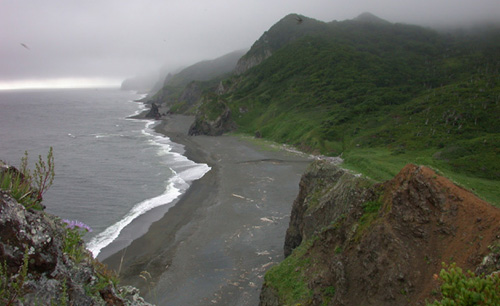 A hill-top view of northern Sakhalin coast. Photo by Wataru Abe.
|
|
Considerable time and effort has gone toward creating, maintaining, and updating our web-site (www.Okhotskia.ws), the heart of which is our search gateway to IKIP and ISIP Databases: (1) Forms-based database search gateway, (2) Map-based locality record browser, and (3) Loans and Gifts of material . Over the past seven years, we have worked hard to make all our data available electronically, but dealing with tens of thousands of specimens, it has been a major undertaking. All of our locality data, from 1994 through 2001, are on-line (8,207 sites on Sakhalin, 30 islands of the Kuril Archipelago, plus the mainland of Kamchatka) and we have entered 19,571 taxonomic records. To date, all of the following have been identified, cataloged, and made available on the web-site: all vascular plants, lichens, mosses, liverworts, Odonata, Plecoptera, aquatic Coleoptera, silphid Coleoptera, cerambycid Coleoptera, and Trichoptera collected from 1994 through 1998; Araneae (spiders), Opiliones (harvesters), Acari (mites), Lithobiomorpha (stone centipedes), Ephemeroptera, heteropteran Hemiptera, carabid Coleoptera, phorid Diptera, and formicid Hymenoptera collected from 1994 through 1997; all Cladocera, Dermoptera, Neuroptera, mymarid Hymenoptera, chrysolmelid Coleoptera collected from 1994 through 1999; all fishes, amphibians, and reptiles collected from 1994 through 2001; all Psocoptera, sternorrhynchan Hemiptera, and mollusks collected in 1994 and 1995; all histerid and cholevid Coleoptera collected in 1995; all syrphid Diptera collected in 1997; and all braconid and bethylid Hymenoptera collected in 1996 (see Table 1).
|
|
HUMAN RESOURCE DEVELOPMENT.Five University of Washington undergraduates, Trevor R. Anderson (terrestrial insects), Staci D. Deschamps (macrofungi), Brooke E. Martin (aquatic insects), Margarita I. Reimer (fishes), and Jessica L. Ward (marine mammal observer) (two supported by REU funds, see below), and four University of Washington graduate students, Gregory C. Jensen (crustaceans and mollusks), Suzanne Joneson (lichens, bryophytes, and plants), Duane E. Stevenson (fishes), and Pamela J. Woods (fishes), all full participants in the 2001 expedition, received training in field work, curatorial practices, and systematics within their areas of interest. Their experience continues here at home as collections are being sorted and identified, and publications prepared.
|
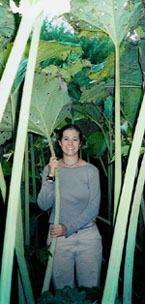   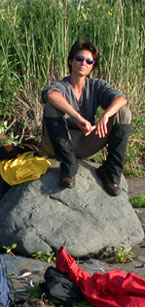 2001 REU participants Staci Deschamps (left), Brooke Martin (left center), and Jessica Ward (right center). Kari Stiles (right) is visiting faculty from the Urban Horticulture department at UW. Photos by Brooke Martin (left and left center) and Jessica Ward (right center and right).
|
REU supplemental support received in 2001 was well used. One of the two recipients, Margarita I. Reimer, now a senior fisheries major at UW, made significant contributions this year. Assigned to ichthyology, she ably assisted in the collection of some 4,138 freshwater and marine fishes, which she helped to sort, label, and identify, much of the work accomplished while still on Sakhalin and aboard ship, and then completed here at UW since our return to Seattle in September. She also spent considerable time collecting other taxa, including freshwater plankton, marine algae, terrestrial insects, and freshwater fish parasites. Even prior to last summer's expedition, Margarita showed a strong interest in fish systematics and ecology, working part time as a curatorial assistant in the UW Fish Collection. During the summer experience, Margarita established a close working relationship with Dr. Marina Shedko, an accomplished and well-published parasitologist at the Institute of Biology and Soil Sciences, Russian Academy of Sciences, Vladivostok. Assisting Dr. Shedko in the field and in the laboratory on a daily basis, Margarita developed a strong interest in freshwater fish parasites, especially those that attack and cling to the inner surface of gill chambers. Favorably impressed with Margarita’s capability and enthusiasm, Dr. Shedko has invited Margarita to work in her laboratory for a month or more sometime in the spring or summer of 2002.
|
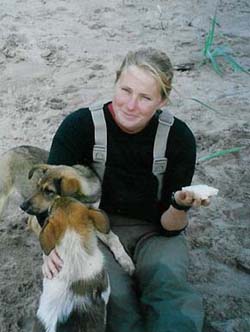 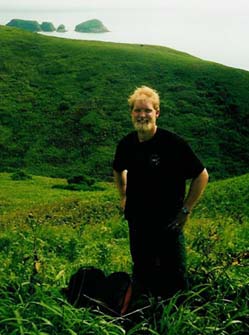 2001 REU participants Margarita Reimer (left), a University of Washington fisheries major, and Trevor R. Anderson (right), a University of Washington zoology major. Photos by Jessica Ward (left) and Pamela Woods (right).
|
Trevor R. Anderson, the second recipient of 2001 REU support, now a senior zoology major at UW, assisted in the collecting, preserving, sorting, and identifying of terrestrial insects during the 2001 expedition, helping to bring back some 4,500 specimens. Since our return from Sakhalin in September, Trevor has put in about 20 hours of work per week curating insects, but also helping with the database and web-site. He is also fully responsible for an all-new design for our Okhotskia homepage and for implementing a new and much faster search engine to query the IKIP/ISIP database. Two veterans of the 1998, 1999, and 2000 expeditions, Suzanne L. Joneson (lichens, bryophytes, and plants) and Daniel J. Bennett (terrestrial insects) preformed brilliantly for us again this summer. Throughout the year, Suzanne (now a second-year graduate student specializing in lichen systematics in the UW Department of Botany) continued to work with members of the Seattle Lichen Group to identify Kuril and Sakhalin Island macrolichens; nearly all have now been identified to genus and many to species. In addition, she prepared a number of loans of lichens to specialists around the world and also entered locality and taxonomic data into the BIOTA/4D database used in the UW Herbarium. In preparation for the 2001 expedition, Suzanne used the database to compile complete lists of plants collected on prior expeditions. These lists allowed us to focus our most recent collecting efforts on previously uncollected taxa. She also helped prepare and package botanical supplies and equipment for shipment to Vladivostok. During the expedition itself, Suzanne was a full participant, collecting 1,162 specimens (789 vascular plants, 350 lichens, and 25 bryophytes). She was energetic and enthusiastic in the field and in the ship's laboratory, where processing specimens and writing notes went on late into the night, seven days a week. In September 2000, she shifted the focus of her graduate research at the UW Department of Botany to lichens. She is now working on a phylogenetic study of fistulose Ramalina along the northern Pacific coast under the supervision of Joe Ammirati. She is the lead author on a paper in preparation on Ramalina of the Kuril Islands.
|
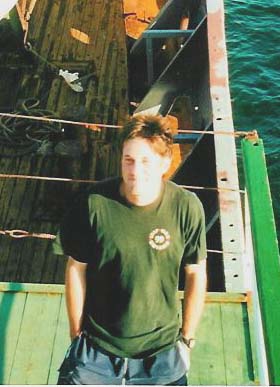 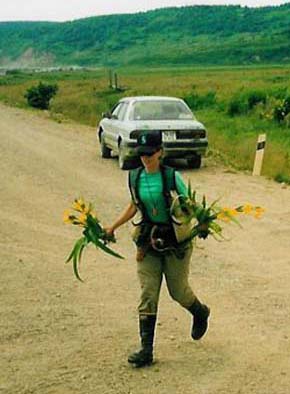 IKIP veterans, Daniel J. Bennett (left), assistant in entomology, and Suzanne L. Joneson holding irises (right), graduate student in botany research . Photos by Pamela Woods.
|
|
Although Daniel J. Bennett, a veteran of the 1998, 1999, and 2000 expeditions, graduated from the UW with a B.S. in Zoology in June 1999, his interest and participation in Russian Far East biodiversity has continued abated. This past summer, he assisted in the collection of approximately 45,000 insects, which he helped to sort, label, and identify to order, much of the work accomplished while still in the field or aboard the research vessel. Since our return from Sakhalin in September, Dan has remained enthusiastic and committed to the project, working almost every day, seven days a week. While responsible over the past three and a half years for curating Hymenopterapersonally pinning more than 25,000 specimenshe has perfected the basic procedures of curation, from generating labels to pinning specimens, all the steps required to prepare insect material for permanent archival storage and professional research. At the same time, he has developed skills in specialized curatorial methods, such as critical-point drying of alcohol preserved insects, and microscopic glue-point mounting of our smallest and most delicate specimens. He is also corresponding and interacting with systematic entomologists around the world as we send various taxa out on loan for identification. He is now investigating graduate programs in entomologyhe plans to specialize in the Braconidae, a family of parasitoid wasps.
|
|
LOANS AND GIFTS.We have worked hard to make our material available to the international scientific community through loans and gifts of specimens. To date, we have made 164 loans and gifts (whole specimens as well as tissues fixed in ethanol) to 113 specialists around the world, totaling 13,529 lots and 151,906 specimens.
|
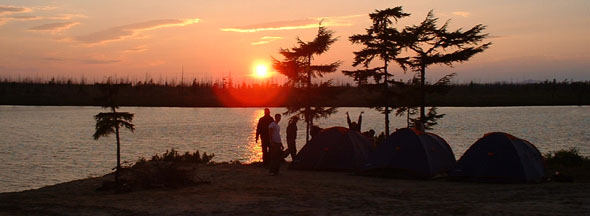 Sun setting over camp at Rybnoye Lake in central Sakhalin Island. Photo by Noboru Minakawa.
|
|
SEMINARS AND MEDIA ATTENTION.We have made a concerted effort to inform academic as well as public audiences about our work through oral presentation, and have received considerable attention from the media in return. To date, veterans of our expeditions have presented 110 popular and scientific talks (including those papers presented at our "International Symposium on Kuril Island Biodiversity"; see below), and have been the subject of some 52 articles in newspapers and magazines. Our 1996 expedition was recorded in full by three employees of the Hokkaido Television Broadcasting Company (Yasumasa Shinomiya, writer; Osamura Hidetoshi, photographer; and Nikolai Shapotin, interpreter), resulting in a 30-minute television production that was aired in Japan on 2 March 1997. A 90-minute show on the people and general natural history of the Kuril Islands, which aired in April 1997, also featured IKIP-1996. Copies of these videos were made available to NSF in spring 1997. The 1997 expedition was recorded in full by South Korean Television, Soo Yong Park, Producer, but we never received copies of the video. With support from NSF and the Japan Society for the Promotion of Science, an "International Symposium on Kuril Island Biodiversity" was held on the Sapporo campus of Hokkaido University, hosted by the Hokkaido University Museum, 18-22 May 2001. Some 68 authors from five nations, including 51 veterans of our seven annual Kuril Island expeditions, as well as four undergraduates and three graduate students from the University of Washington, shared the results of our collaborative work with a large audience of scientists and the lay public. Forty-four oral presentations and 14 posters were presented, covering a huge diversity of plant and animal taxa, from lichens to liverworts, to flies and fishes, and reflecting highly varied approaches to the study of biodiversity, from check-lists and descriptions of new taxa, traditional morphological studies as well as molecular, to phylogenetic and zoogeographic analyses. For a full overview, click on "International Symposium" from our "Okhotskia" homepage: www.Okhotskia.ws. PUBLICATIONS.One hundred and fifty-four papers have now been published. An additional two are in press, one submitted, and several others are at various stages of preparation. Forty descriptions of new taxa have been published or are currently in press or submitted for publication: three new species of caddisflies (Trichoptera: Hydroptilidae, Leptoceridae), two new stoneflies (Plecoptera: Perlodidae), one new beetle (Coleoptera: Carabidae), six new flies (Diptera: Phoridae, Scathophagidae, Syrphidae), one new bug (Hemiptera: Miridae), ten new parasitoid wasps (Hymenoptera: Braconidae), one new genus and two new species of mites (Acari: Acaridae, Eviphidae), one new millipede (Diplopoda: Diplomaragnidae), six new freshwater bivalves (Bivalvia: Unionidae, Anodontidae), five new terrestrial and freshwater gastropods (Gastropoda: Planorbidae, Valvatidae), and three new fishes (Teleostei: Osmeridae, Cottidae, Gobiidae). Among our larger publication efforts is Y. N. Zhuravlev and A. S. Kolyada's book on the biology of ginseng published in 1996: Araliaceae: Ginseng and Other Aralia of the Russian Far East, Dalnauka, Vladivostok, 280 pp., 41 black and white figures, 8 color plates, 11 tables, and 859 bibliographic references. That portion of the book that covers Kuril Island species was funded in part by DEB-9400821 and DEB-9505031; NSF is properly acknowledged on page 1 of the front matter.
|
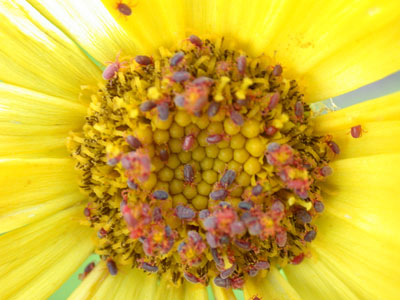 Trombidioid mites on an aster from Sakhalin Island. Photo by Wataru Abe.
|
Our second larger publication effort, for which we received supplemental support from NSF, is an English translation of G. O. Kryvolutskaja's Entomofauna of the Kuril Islands, originally published in 1973 by the Institute of Biology and Soil Sciences, Far-Eastern Scientific Center, Russian Academy of Science, which is being edited, augmented, illustrated in color, and made available electronically. The book has now been completely translated by Elliott B. Urdang, M.D., M.A. in Russian, of Providence, Rhode Island, and all parts have been delivered to us by diskette and hard-copy: the Abstract, Preface, and Table of Contents (5 pages), Chapter 1, "History of investigations of the insect fauna of the Kuril Islands" (7 pages); Chapter 2, "General information on the insects of the Kuril Islands" (8 pages); Chapter 3, "Accounts of insect taxa of the Kuril Islands" (including methods and materials, keys, descriptions, and general taxonomic accounts by order; 130 pages); Chapter 4, "Ecological and geographic review of the Kuril Island entomofauna" (including physical conditions of the Kuril Islands, ecological features of the Kuril Islands, and insect assemblages and primary habitats of the Kuril Islands; 82 pages); Chapter 5, "Speciation on the Kuril Islands" (10 pages), Chapter 6, "Zoogeography of the Kuril Island entomofauna" (including geological history and floral evolution, zoogeographic origins and trends, and subdivision of the Kuril Archipelago based on insect distributions; 28 pages); Conclusions (4 pages); Summary (2 pages); Literature cited (15 pages), Index of scientific names of insects (19 pages); List of scientific and Russian names of plants (2 pages); all the tables (22); and the legends to all the figures (67). While some of the text requires additional editing, the entire book, including all figures and tables, is now available on the web-site. Color illustration of the work, with photographs taken by members of the IKIP insect team, is in progress. Similar plans to publish electronically V. Y. Barkalov's Plants of the Kuril Islands, are currently on hold while we await delivery of the manuscript. Although promised to us back in June 1997, his approximately 650-page work remains unfinished.
|
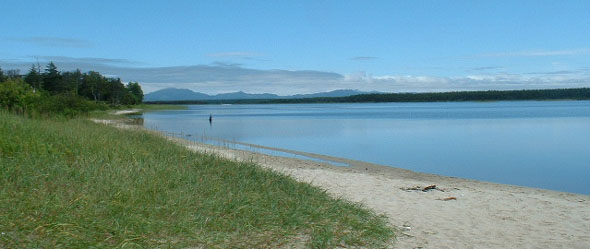 Sampling in the large freshwater Khvalisekoye Lake of Southern Sakhalin Island. Photo by Noboru Minikawa.
|
|
|
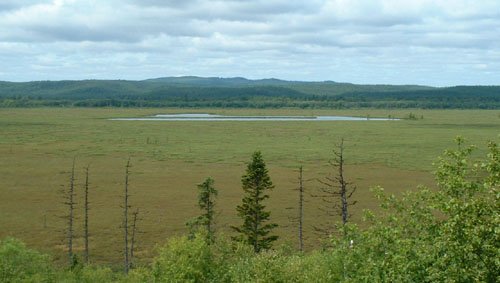 Freshwater marsh lake and evergreen forest in north-central Sakhalin. Photo by Noboru Minakawa. |
NEW DIRECTIONS AND PLANS FOR SUMMER 2002.The enormous potential for biotic survey in the Russian Far East has been demonstrated by our successful seven-year effort in the Kuril Archipelago and this initial year on Sakhalin. With this experience now behind us, we propose to put the Kuril work into the broader context of a long-term, large-scale survey and inventory that encompasses all of Okhotskia, here defined as the landmasses that surround and enclose the Sea of Okhotsk: (1) the Kuril Islands in the southeast (now being surveyed as Phase 1), (2) Sakhalin Island in the west (Phase 2, this proposal), (3) the Okhotsk coast of southeastern Siberia (i.e., Khabarovsk and Magadan provinces) in the north (Phase 3, a future proposal), and (4) Kamchatka in the northeast (Phase 4, a future proposal). For more, see www.Okhotskia.ws, our new gateway to biotic survey and inventory in the Russian Far East. As one of four primary source biotas for colonization of the Kuril Islandsthe others being Hokkaido, Kamchatka, and the Asian mainlandSakhalin is by far the least known biologically and in the greatest danger of over-exploitation. Narrowly separated from the continent for nearly 1,000 km and almost touching Hokkaido, Japan, at its southern tip, it forms a natural filter or barrier to dispersal of plants and animals from the Asian mainland to the Kurils. Although considerable information is available for wide-ranging, commercially important species, such as king crab, salmon, cod, and various marine mammals, the flora and fauna of Sakhalin as a whole are poorly known. At the same time, a steep rise in commercial exploitation of natural resources poses a serious environmental threat to the island.
|
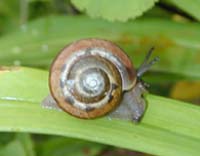 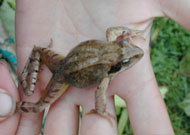 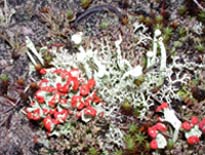 A Stylommatophor snail (left), the frog Rana chensinensis (center), and the lichen Cladonia sp. ("British soldiers"). Photos by Pamela Woods (left and center) and Wataru Abe (right). |
Viewing Sakhalin as a logical and much needed extension of our work in the Kurils, the National Science Foundation has awarded two additional years of funding (DEB 0202175), which will provide support for two more expeditions, in 2002 and 2003, bringing the total number of consecutive expeditions in the Russian Far East to ten. With NSF funds now in hand for a return to Sakhalin summer 2002 (approximately 20 July8 September), we will survey the southern half of the island, encompassing the southern tip and all the territory that lies along the western slope of the Western Sakhalin Mountains as far north as the town of Aleksandrovsk-Sakhalinsk, and covering the Tym-Poronaiskaya Valley and the outer and inner slopes of the Eastern Sakhalin Mountains. In 2003, we will survey the northern half, extending from Aleksandrovsk-Sakhalinsk to the mouth of the Bolshaya River on Baykal Bay, and from the mouth of the Bolshaya to Mount Lopatin and the northern terminus of the Eastern Sakhalin Mountain range. Thank you for the generous support we have received. We hope this brief report meets with your satisfaction.
|
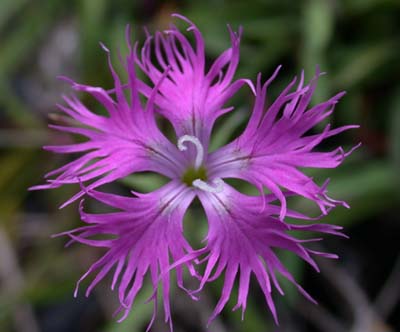 Dianthus superbus, the true carnation. Photo by Wataru Abe.
|
|
|
![]()
